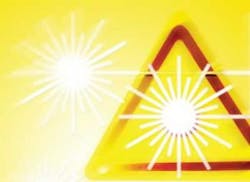As laser applications expand,users must ensure theirsafe operation, maintenance,and service
by William J. Ertle and Darrell Seeley
The year 2009, marking the 50th anniversary of the laser, is one of great economic pressures in companies presenting challenges for industrial laser manufacturers and users in establishing and maintaining their laser safety program. We present several aspects of a thorough program, discussing some of the key points.
Laser manufacturers
Those who manufacture lasers and laser systems for sale or delivery within the United States (systems designed for laser cutting, welding, marking etc.) are required to certify, that is guarantee, that their product complies with the Federal Laser Product Performance Standard (FLPPS), also identified as 21CFR Subchapter J, parts 1040.10 and 1040.11. The US Center for Devices and Radiological Health (CDRH), a part of the FDA, administers this law, and it applies to all lasers and laser systems regardless of their type or application. The manufacturer must first classify the laser product into one of four main laser hazard classes and then meet the federal safety requirements for that hazard class.
Lasers and laser systems sold outside the U.S. should comply with IEC 608251-1, 2nd Ed. Part 1: Equipment classification and requirements. IEC stands for International Electrotechnical Commission, an organization that writes international standards or norms.
Lasers used in materials processing applications such as cutting, marking, welding, and so on, are always Class 4 lasers. Specifically, Class 4 denotes the hazard class of those lasers that pose the highest potential for eye and/or skin injury due to over-exposure to laser radiation. However, a laser is just one component of a laser system. While a laser may be Class 4, a laser system may include multiple lasers, parts handling, and enclosures. If the enclosures are designed in such a way that exposure to laser radiation is impossible during normal operation, then it is a Class 1 laser system with an embedded Class 4 laser. It is potentially hazardous only during those maintenance or service procedures that require temporary access to the laser beam.
Laser users
As the owner or user of a laser or laser system in the U.S. you should verify that it has been properly certified by its manufacturer. Look for the certification label affixed to the laser and also on the laser system enclosure, because each is separately certified by its manufacturer for U.S. federal compliance. As the owner or user of a laser or laser system outside the U.S. you should purchase lasers or laser systems that comply with the IEC 60825-1 standard. In this case, compliance information is generally found in the operating manual.
Exposure to Class 4 levels of laser radiation can present both serious skin and eye hazards. Other laser hazards not directly associated with the beam may exist as well, including laser generated air contaminants, high voltage hazards in the laser power supply, and potential ignition of combustible materials.
As the laser user, you must ensure the safe operation, maintenance, and service of your laser or laser system. In the U.S., OSHA (both federal and state) recognizes ANSI Z136.1 for Safe Use of Lasers as the industry safety standard in this regard. Outside the U.S., IEC TR 60825-14 Safety of laser products – Part 14: A user’s guide is the corresponding laser user’s standard.
Both of these laser user standards establish the primary component of an industrial laser safety program as the designation, by management, of an individual to be responsible for the knowledgeable evaluation of laser hazards and the implementation of appropriate control measures. That individual is called the Laser Safety Officer (LSO). The LSO’s responsibilities are detailed in both standards, as are the control measures necessary to mitigate the hazards posed by each laser hazard class. The LSO must of course determine how to best institute these control measures to protect laser personnel.
A second and no less important component of the laser safety program is in-depth laser safety training for the LSO and laser safety awareness training for those who may potentially be exposed to hazardous levels of laser radiation, whether during normal operation of a Class 4 laser or maintenance or service of a Class 1 laser system with an embedded Class 4 laser.
RLI has been tracking laser incidents for more than 30 years (www.rli.com/incidents). The data clearly reflects that initial and refresher laser safety training is the most effective way to reduce accidents in the workplace, and from a business perspective, one of the most cost-effective.
Summary
Industrial laser applications continue to increase and the manufacturers of the laser strive to get greater power levels from smaller units. The types of lasers are ever expanding with new and more exciting applications introduced frequently. The laser has become a commonly used tool in industry and for that growth to continue, safety practices must be followed, especially as the higher power, smaller devices become more common.
William J. Ertle - CLSO, is with Rockwell Laser Industries, Cincinnati, Ohio, and Darrell Seeley – CLSO is with Laser Safety Consulting, LLC, Wales, WI.
